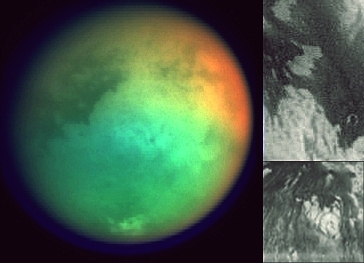
 Unveiled Titan. The NASA/ESA/Italian Space Agency Cassini-Huygens mission successfully performed its first scientific flyby at Titan, the largest Saturnian moon, on October 26th, 2004. The mission is a 4-year tour of the Saturnian system. The craft grazed the largest of Saturnian moons by 730 miles (1,174 km). Titan's surface was mostly unknown until that date -except a first imaging session of the moon when the Cassini spacecraft inserted into Saturn's orbit after its interplanetary journey, as the moon is enshrouded into a heavy hood of clouds. The view left is giving a global view of the albedo features seen under the clouds layer as the two insets are showing most detailed pictures ever of Titan (the bottom inset was taken at moon's closest). Titan might represent a good sample of what the primitive Earth was looking like and of how the primordial atmosphere might have been part of the emergence of life. Titan's atmosphere is manufacturing organic molecules due to interaction with Sun's ultraviolet. As far as the surface of Titan is concerned it appears from these pictures that multiple processes have been at work there -of them possibly plate tectonics, that it bears few impact marks and that Titan might be revealing a geology which was never seen before in the solar system. picture © site 'Amateur Astronomy' based on pictures NASA/JPL/Space Science Institute (left, and top inset) and NASA/JPL/University of Arizona (bottom inset)
Unveiled Titan. The NASA/ESA/Italian Space Agency Cassini-Huygens mission successfully performed its first scientific flyby at Titan, the largest Saturnian moon, on October 26th, 2004. The mission is a 4-year tour of the Saturnian system. The craft grazed the largest of Saturnian moons by 730 miles (1,174 km). Titan's surface was mostly unknown until that date -except a first imaging session of the moon when the Cassini spacecraft inserted into Saturn's orbit after its interplanetary journey, as the moon is enshrouded into a heavy hood of clouds. The view left is giving a global view of the albedo features seen under the clouds layer as the two insets are showing most detailed pictures ever of Titan (the bottom inset was taken at moon's closest). Titan might represent a good sample of what the primitive Earth was looking like and of how the primordial atmosphere might have been part of the emergence of life. Titan's atmosphere is manufacturing organic molecules due to interaction with Sun's ultraviolet. As far as the surface of Titan is concerned it appears from these pictures that multiple processes have been at work there -of them possibly plate tectonics, that it bears few impact marks and that Titan might be revealing a geology which was never seen before in the solar system. picture © site 'Amateur Astronomy' based on pictures NASA/JPL/Space Science Institute (left, and top inset) and NASA/JPL/University of Arizona (bottom inset)
Website Manager: G. Guichard, site 'Amateur Astronomy,' http://stars5.6te.net. Page Editor: G. Guichard. last edited: 12/28/2010. contact us at ggwebsites@outlook.com

